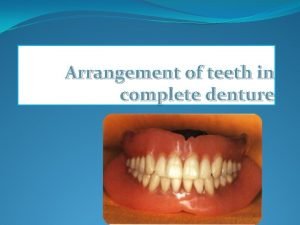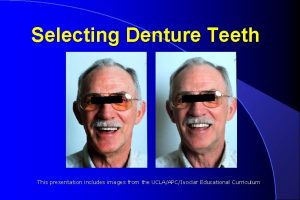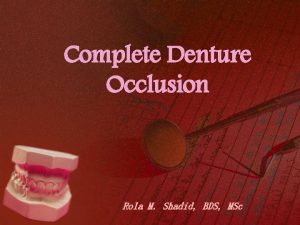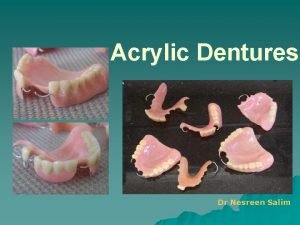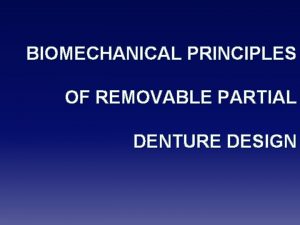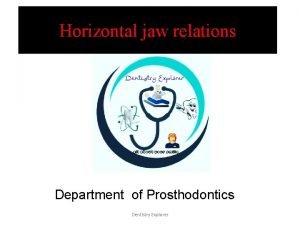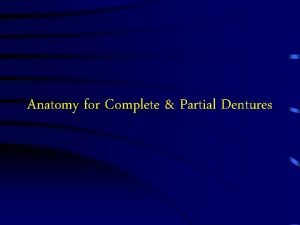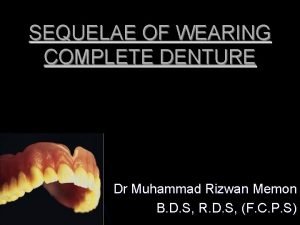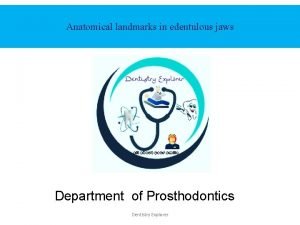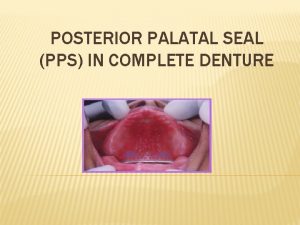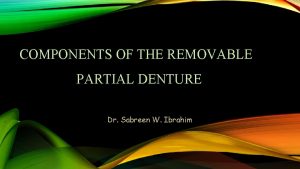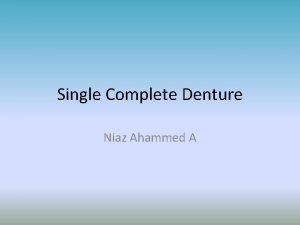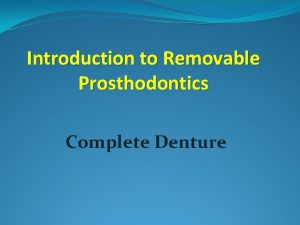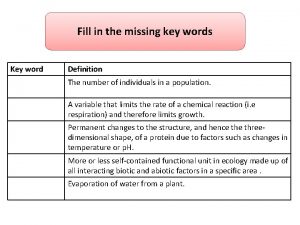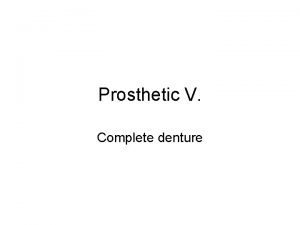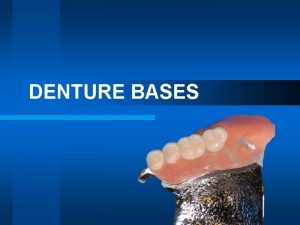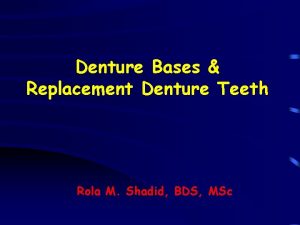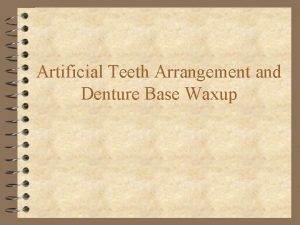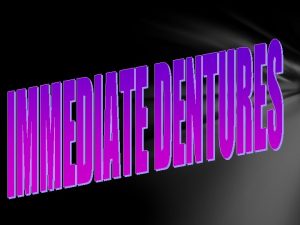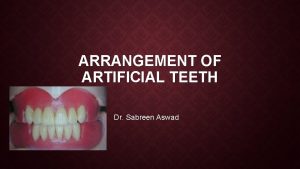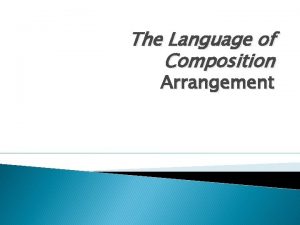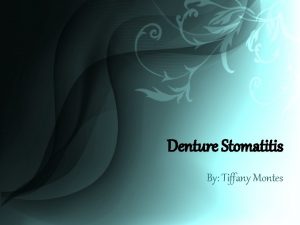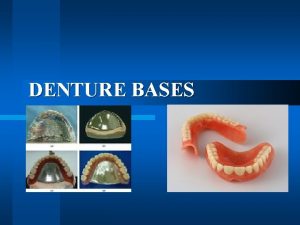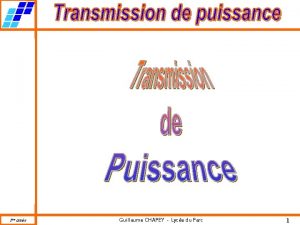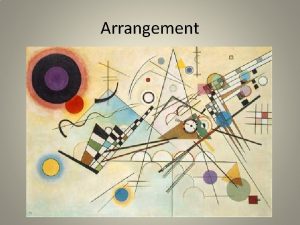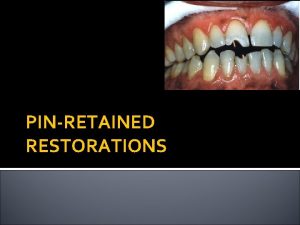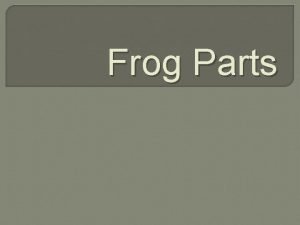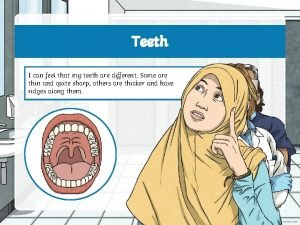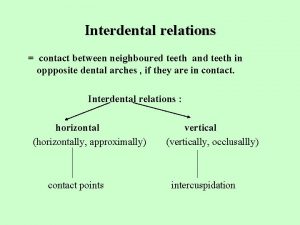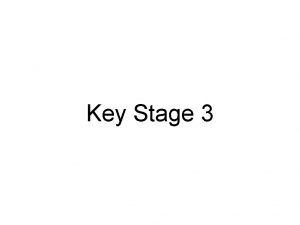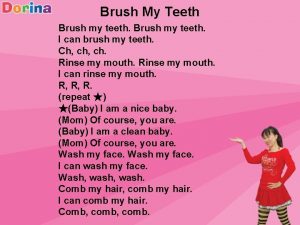Arrangement of teeth in complete denture The four










































- Slides: 42

Arrangement of teeth in complete denture

The four principal factors that govern the positions of the teeth for complete dentures are (1) the horizontal relations to the residual ridges, (2) the vertical positions of the occlusal surfaces and incisal edges between the residual ridges, (3) the esthetic requirements, and (4) the inclinations for occlusion 2

Individual orientation of maxillary teeth 3

ARRANGING TEETH FOR COMPLETE DENTURE OCCLUSION Maxillary Central Incisor: The long axis of the tooth is perpendicular to the horizontal (labiolingual inclination) Its long axis slopes towards the vertical axis ( mesiodistal inclination) Slopes labially about 15 degrees when viewed from the side. Incisal edge is in contact with the occlusal plane. 4

Teeth is set on the occlusal rim 5

Maxillary Lateral Incisor: Long axis slopes rather more towards the midline Inclined labially about 20 degrees when viewed from the side The neck is slightly depressed The incisal edge is about 1 mm short of the occlusal plane. 6

7

Maxillary Canine : Its long axis is parallel to the vertical axis when viewed from both the front and side or it may be slightly to the distal. The bulbous cervical half of the tooth provides its prominence. Its cusp is in contact with the horizontal plane. . The neck of the tooth must be prominent 8

9

Remaining maxillary teeth are arranged on the other side of the arch to complete the anterior set up. To maintain the set teeth in position, the wax supporting the teeth must be heated and sealed both to the teeth and to the record base. 10

11

12

First premolar: �Long axis is parallel to the vertical axis when viewed from the front or the side. �Its palatal cusp is about 1 mm short of, and its buccal cusp in contact with, the occlusal plane. 13

Second premolar: �Its long axis is parallel with the vertical axis when viewed from the front or the side. �Both buccal and palatal cusps are in contact with the occlusal plane. 14

First molar: �Long axis slopes buccally when viewed from the front, and distally when viewed from the side. �Only mesiopalatal cusp is in contact with the occlusal plane. 15

Second molar: �Long axis slopes buccally more steeply than the first molar when viewed from the front, and distally more steeply when viewed from the side. �All four cusps are clear of the occlusal plane, but the mesiopalatal cusp is nearest to it. 16

Maxillary teeth set checked on occlusal plane 17

18

Orientation and arrangement of mandibular teeth 19

Arranging the Mandibular Teeth Mandibular central incisor: �Long axis slopes slightly towards the vertical axis when viewed from the front. �Slopes labially when viewed from the side. �Incisal edge is about 2 mm above occlusal plane 20

Mandibular lateral incisor: �Long axis inclines to vertical axis when viewed from the front �Slopes labially when viewed from side but not so steeply as the central incisor. �Incisal edge is about 2 mm above occlusal plane 21

Mandibular canine: �Long axis leans very slightly towards the midline when viewed from the front. �Leans very slightly lingually when viewed from the side �Neck is slightly prominent and the tooth is tilted to the distal �Tip at same level as incisors. 22

23

24

Teeth arrangement checked in patient mouth 25

First molar: �Long axis leans lingually when viewed from the front and mesially when viewed from the side. �All cusps are at a higher level above the occlusal plane than those of the second premolar. � The buccal and distal cusps are higher than the mesial and lingual. � The mesiobuccal cusp occludes in the fossa between upper second premolar and first molar. 26

Mandibular 1 st Molar �Facial: Long axis leans mesially, when viewed from side. �Proximal : Long axis inclines Lingually, when viewed from front. �Occlusal: Buccal cusps are higher than Lingual cusps. Distal cusps are higher than Mesial cusps. 27

Second premolar: �Long axis is parallel to the vertical plane when viewed from both the front and the side. �Both cusps are about 2 mm above the occlusal plane. � The buccal cusp contacts the fossa between the two upper premolars. 28

Mandibular 2 nd Premolar �Facial & Proximal : Long axis is vertical from both views. �Occlusal : Both cusps are about 1 -2 mm above Occlusal plane 29

First premolar: �Long axis is parallel to the vertical plane when viewed from the front and the side. �Its lingual cusp is below the horizontal plane �Its buccal cusp is about 2 mm above it as it contacts the mesial marginal ridge of the upper first premolar. 30

Mandibular Ist Premolar �Facial : Long axis is parallel to vertical plane. �Proximal : Long axis is parallel to vertical plane. �Occlusal : Buccal cusp is above the occlusal plane, whereas Lingual cusp is below occlusal plane. 31

32

Second molar: �Lingual and mesial inclination of the long axis is more pronounced than in the case of the first molar. �All the cusps are at a higher level above the occlusal plane than those of the first molar, the distal and buccal cusps more so than the mesial and lingual. � The mesiobuccal cusp contacts the fossa between the two upper molars. 33

Mandibular 2 nd Molar �Facial : Mesial inclination is more than 1 st molar. �Proximal : Lingual inclination is slightly more than 1 st molar. �Occlusal : Buccal cusps are higher than Lingual. Distal cusps are higher than Mesial. 34

35

36

Key of occlusion �Canine key of occlusion �The distal arm of the lower canine should align with the mesial arm of the upper canine. 37

�Molar key of occlusion �The mesiobuccal cusp of the maxillary permanent molars should coincide with the mesiobuccal groove of the mandibular permanent molar 38

Overjet & overbite �Overjet denotes the distance between the upper & lower incisor measured in horizontal plane - 2 mm �Overbite denotes the vertical overlap of the maxillary and mandibular anterior – 2 mm 39

Overjet overbite 40

41

42
 Overjet and overbite in complete denture
Overjet and overbite in complete denture Complete denture teeth arrangement
Complete denture teeth arrangement Portrait denture teeth mould guide
Portrait denture teeth mould guide Advantages of balanced occlusion
Advantages of balanced occlusion Every denture design
Every denture design Some animals are dangerous *
Some animals are dangerous * Laws of balanced occlusion
Laws of balanced occlusion L beam effect rpd
L beam effect rpd Classification of denture stomatitis
Classification of denture stomatitis Nick and notch
Nick and notch Balanced vs lingualized occlusion
Balanced vs lingualized occlusion Angle of lip
Angle of lip Direct sequelae in wearing cd
Direct sequelae in wearing cd Final impression techniques
Final impression techniques Pendulous tuberosity
Pendulous tuberosity Landmarks in prosthodontics
Landmarks in prosthodontics Anterior and posterior vibrating line
Anterior and posterior vibrating line Retention definition in prosthodontics
Retention definition in prosthodontics Component of removable partial denture
Component of removable partial denture Single complete denture
Single complete denture Complete denture definition gpt
Complete denture definition gpt Buccal flange denture
Buccal flange denture What are subjects and predicates
What are subjects and predicates Bacterial growth
Bacterial growth Tư thế ngồi viết
Tư thế ngồi viết đặc điểm cơ thể của người tối cổ
đặc điểm cơ thể của người tối cổ Cái miệng xinh xinh thế chỉ nói điều hay thôi
Cái miệng xinh xinh thế chỉ nói điều hay thôi Mật thư anh em như thể tay chân
Mật thư anh em như thể tay chân Bổ thể
Bổ thể ưu thế lai là gì
ưu thế lai là gì Tư thế ngồi viết
Tư thế ngồi viết Thẻ vin
Thẻ vin Thơ thất ngôn tứ tuyệt đường luật
Thơ thất ngôn tứ tuyệt đường luật Các châu lục và đại dương trên thế giới
Các châu lục và đại dương trên thế giới Từ ngữ thể hiện lòng nhân hậu
Từ ngữ thể hiện lòng nhân hậu Diễn thế sinh thái là
Diễn thế sinh thái là V. c c
V. c c Vẽ hình chiếu vuông góc của vật thể sau
Vẽ hình chiếu vuông góc của vật thể sau 101012 bằng
101012 bằng Tỉ lệ cơ thể trẻ em
Tỉ lệ cơ thể trẻ em Hát lên người ơi alleluia
Hát lên người ơi alleluia Hươu thường đẻ mỗi lứa mấy con
Hươu thường đẻ mỗi lứa mấy con Lời thề hippocrates
Lời thề hippocrates
